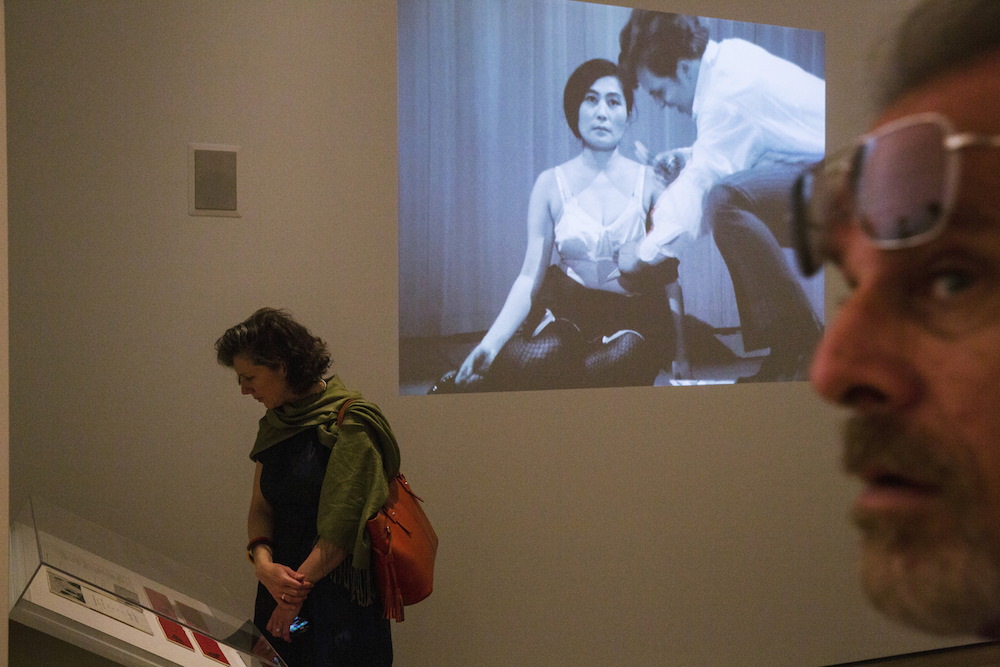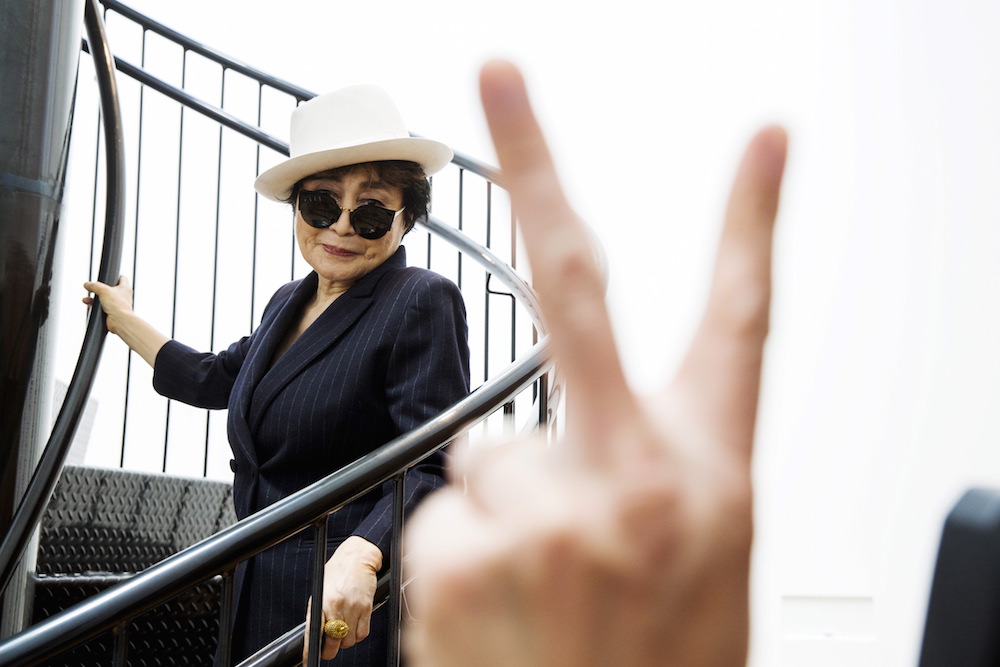Artist Yoko Ono's show runs until September in New York.
Yoko Ono has had to wait a while for her first retrospective at the Museum of Modern Art, though not for want of trying. In 1971, several New York newspapers ran ads for a “one-woman show” that Ono was presenting at the museum. But anyone who came down to West 53rd Street would have seen no show at all, only a man with a sandwich board outside the museum entrance.
Ono, the man explained, had released a number of flies in the sculpture garden; they could be in the museum now, or anywhere in Manhattan. In the catalogue she published, she appears in the garden with a large glass bottle full of the creatures, but on inspection it’s clear that even the release of the flies never happened. It was just a photomontage.
Who knows whether Ono ever thought she would really get the retrospective she faked in 1971. But now, at the age of 82, her first (or is it second?) one-woman show really has opened at the MoMA, and it goes a long way to revalorising one of the most misunderstood artists of the last 60 years.
Her massive fame, and maybe her heal-the-world rhetoric too, has obscured the groundbreaking contributions she made to the art of the 1960s and beyond. At last, the art world has come round. This show – finely curated by Christophe Cherix , the museum’s head of drawings and prints; and Klaus Biesenbach , its chief curator at large – is no guerrilla occupation. It is a belated and jubilant rectification of the historical record, and a victory lap for an artist laughed at for too long.
Much of the early work on display here is drawn from a major gift MoMA received in 2009 of artworks, correspondence and documentation related to Fluxus , an impish and fluid movement with which Ono was partially associated. The Fluxus artists, notably George Brecht and George Maciunas , favored performances and publications with a prankish tone. Ono’s art was pithier, and dreamier.

Her essential 1964 book Grapefruit – the typescript for which is displayed here page by page – consisted of nothing but terse, open-ended instructions for readers to follow. Some could actually be executed: “Cut a painting up and let it be lost in the wind.” Others went far beyond any rational applicability:
“SMELL PIECE
Send the smell of the moon.
1953 autumn
COLLECTING PIECE II
Break a contemporary museum into pieces with the means you have chosen. Collect the pieces and put them together again with glue.1963 autumn
Many years before the ” dematerialization of the art object ” – the critic Lucy Lippard’s phrase for the turn away from objects and towards ideas in American art of the late 1960s – Ono was creating artworks that could exist as mere instructions, to be executed once, multiple times, or never. A solo show in 1961 consisted of sumi-ink paintings on unstretched canvas, executed according to simple directions: one is burned, another placed on the ground, another drips with water. (Ono has recreated the paintings for this show.)
Cut Piece, her most famous artwork, began as a score as well: sit alone on a stage with a pair of scissors before you, and let audience members snip off bits of your clothes one by one. She performed it twice in Japan in 1964, and a recording here of a later iteration at Carnegie Hall shows Ono seated on the floor, back ramrod straight, face expressionless. A man with a dumb smile comes on stage and slices her blouse, exposing her bra. She looks forward, impassive. Another cut. She crosses her arms to keep her bra from falling, but the face never changes. She is utterly victimised, but unyielding.
Cut Piece remains one of the most vexing works of performance art of the 1960s, and it now stands as a precursor to whole swaths of feminist and body-centered art. Not less importantly, it also expresses the deep influence of Zen Buddhism, or at least western promulgations of it, on the art of the 1960s.
(Last year she told the Guardian’s Jonathan Jones that when she created Cut Piece, “I was originally thinking of the Buddha and how he gave everything up.”)
MoMA’s curators touch on this only lightly: in the same gallery as Cut Piece, they have included ephemera from an all-night event she staged in 1964 at Nanzen-ji, a Zen Buddhist temple in Kyoto. Yet Zen was a near obsession of artists, writers and composers of the mid-century American avant garde, from Robert Rauschenberg and Jasper Johns to Allen Ginsburg and especially John Cage – a frequent collaborator whom Ono befriended as early as the 1950s.
Ono, both in her Japanese education and her American artistic formation, drew parallels between spiritual and religious practices (mostly Buddhist, but at times Christian) and artistic creation, and saw her own art as less a means of representation than a portal to a new, freer mindfulness. “At this point,” Ono wrote in 1966 , “what art can offer Ö is an absence of complexity, a vacuum through which you are led to a state of complete relaxation of mind.”
Ono’s Zen-like instructions and performances of the early and mid-1960s are far more compelling than her sculptural work, which tend to cuteness and one-liner-ism. Half a Room (1967) is just that: a chair, a suitcase, a space heater, each slashed in half and painted white.
Three Spoons, from the same year, consists of a Plexiglas pedestal that contains not three but four spoons. These mid-60s works are pretty twee, though one in particular has historical significance: a stepladder, painted all white, above which Ono hung a framed piece of paper on which she typed the single word YES. You can’t climb the ladder now, but you could in 1966, at the Indica Gallery in London. John Lennon did –and soon Ono became, in Lennon’s phrase, “the world’s most famous unknown artist”.

Everything changes after that. Cherix and Biesenbach have done their best work in this second half of the show, correcting the most enduring falsehood surrounding Ono’s career: that she was some avant-garde harpy who glommed on to Lennon’s fame, turned him into some far-out conceptualist, and (have you heard?) broke up the Beatles.
In fact, Lennon influenced Ono as much as Ono influenced Lennon, in ways that improved both of their careers. If her best art before Lennon encouraged a Zen-like dissolution of thought, after Lennon she attached that refusal of distinction and dualism to a greater campaign for world peace, waged not in galleries but in the mass media. They married in 1969; for their honeymoon, the couple invited the press to their Amsterdam hotel room, where they stayed in bed for a week. The same year they launched a massive ad campaign: war is over , the billboards proclaimed, from New York to Tokyo.
Many of these happenings were accompanied by music – both hits like Give Peace a Chance and Happy Xmas (War Is Over) , and tougher fare like Amsterdam , a 25-minute track in which Ono warbles, over and over, “Let’s pray for peace.” Mocked for too long by overprotective Lennon fans, Ono’s music is finally getting the appreciation it deserves – and at the end of this fine retrospective, in a soundproof room, you can jam to the Plastic Ono Band’s decades of ambitious, surprising music, the work of a still undervalued artist who, more than most, trusted her audience to do as they pleased. You can make a painting, in a gallery or in your head. You can cut out the sky. Even war is over, if you want it.
Yoko Ono: One Woman Show, 1960-1971 , Museum of Modern Art, New York, until 7 September – (c) Guardian News & Media Ltd, 2015